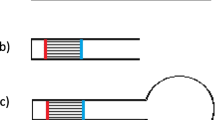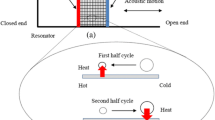Abstract
This work is primarily concerned with the experimental investigation of the performance of a standing wave thermoacoustic engine (TAE). The TAE technology converts thermal power into acoustic power which may be used to generate electricity or, to drive thermoacoustic cooling devices. Although there is a number of existing researches that suggest the link between the geometrical configuration of the device and its performance, there are no existing work that point out how to incorporate this aspect in the designing. Therefore, this study proposes the use of an adjustable TAE in order to alter the performance of the device while in operation. This new TAE model has an adjustable resonator length, which consisted of a 103 mm (4-in.) honeycomb ceramic stack sample, buffer volume and a cooling shell-tube heat exchanger was developed. Six different stacks were used to evaluate the performance of the TAE. Three different stack lengths (50, 100, and 150 mm), positioned at three different locations, were investigated. These locations were measured from the hot ends of the stack to the pressure antinode. In addition, the influence of the mean pressure and the working gas was investigated. Measurement of temperature difference across the stack and sound pressure levels at the steady state were used to determine the efficiency of the device. Through the adjustment of the resonator length, this study point out the benefit of choosing the best frequency so that TAE can work optimally and produce higher acoustic power.


















Similar content being viewed by others
Abbreviations
- a :
-
Speed of sound; (m.s−1)
- cp :
-
Specific heat capacity; (J/kgK)
- f:
-
Frequency; (Hz)
- l:
-
Half plate -thickness; (mm)
- p:
-
Pressure; (Pa)
- x:
-
Stack position; (mm)
- y0 :
-
Half plate -gap; (mm)
- BR:
-
Blockage ratio
- DR:
-
DRIVE ratio
- K:
-
Thermal conductivity; (W/mK)
- R:
-
Specific gas constant; (J/kgK)
- ∆T :
-
Temperature difference
- δk :
-
Thermal penetration; (mm)
- δv :
-
Viscous penetration; (mm)
- γ:
-
Adiabatic coefficient
- ρ:
-
Density; (kg/m3)
- σ:
-
Prandtl number
- ω:
-
Angular frequency; (rad/s)
- m:
-
Mean
- g:
-
Gas properties
- s:
-
Stack properties
- n:
-
Normalised
References
Ibrahim A, Arafa N, Khalil E (2011) Geometrical optimization of thermoacoustic heat engines. In: 49th AIAA Aerospace Sciences Meeting including the New Horizons Forum and Aerospace Exposition, Orlando, p 129
Wheatley JC, Swift GW, Migliori A (1986) The natural heat engine. Los Alamos Science 14(2):2–33
Swift GW (1988) Thermoacoustic engines. J Acoust Soc Am 84(4):1145–1180
Setiawan I, Achmadin WN, Murti P, Nohtomi M (2016) Experimental study on a standing wave thermoacoustic prime mover with air working gas at various pressures. J Phys Conf Ser 710(1):012031. https://doi.org/10.1088/1742-6596/710/1/012031
Tartibu LK (2018) Impact of ceramic substrates geometry on the performance of simple thermo-acoustic engines. Exp Tech 42:155–176
Hariharan NM, Sivashanmugam P, Kasthurirengan S (2012) Optimization of thermoacoustic primemover using response surface methodology. HVAC&R Research 18(5):890–903
Hariharan NM, Sivashanmugam P, Kasthurirengan S (2015) Studies on performance of thermoacoustic prime mover. Experimental Heat Transfer 28(3):267–281
Setiawan I, Murti P, Achmadin WN, Utomo AB, Nohtomi M (2016) Design, construction and evaluation of a standing wave thermoacoustic prime mover. AIP Conference Proceedings 1717(1):050007. https://doi.org/10.1063/1.4943482
Jin T, Zhang BS, Tang K, Bao R, Chen GB (2007) Experimental observation on a small-scale thermoacoustic prime mover. Journal of Zhejiang University-SCIENCE A 8(2):205–209
Kalra S, Desai KP, Naik HB, Atrey MD (2015) Theoretical study on standing wave thermoacoustic engine. Phys Procedia 67:456–461
Cahyadi DD, Adhitama YN, Setiawan I, Utomo AB (2017) Experimental Study of Resonance Frequency at Prime Mover Thermoacoustic Standing Wave. Journal of Physics: Theories and Applications 1(2):157–166
Alcock AC, Tartibu LK, Jen TC (2017) Design and construction of a thermoacoustically driven thermoacoustic refrigerator. In: Proceedings of the 2017 International Conference on the Industrial and Commercial Use of Energy (ICUE). https://doi.org/10.23919/ICUE.2017.8103430
Ishikawa H, Hobson PA (1996) Optimisation of heat exchanger design in a thermoacoustic engine using a second law analysis. International Communications in Heat and Mass Transfer 23(3):325–334
Gholamrezaei M, Ghorbanian K (2016) Thermal analysis of shell-and-tube thermoacoustic heat exchangers. Entropy 18(8):301
Herman C, Travnicek Z (2006) Cool sound: the future of refrigeration? Thermodynamic and heat transfer issues in thermoacoustic refrigeration. Heat Mass Transf 42(6):492–500
Yu G, Wang X, Dai W, Luo E (2013) Study on energy conversion characteristics of a high frequency standing-wave thermoacoustic heat engine. Appl Energy 111:1147–1151
Arafa N (2010) Towards a Better Performance of Thermacoustic Devices. MSc. Thesis, Cairo University, Cairo, Egypt
Acknowledgements
This research was supported by the Faculty of Engineering of the University of Johannesburg, Johannesburg, South Africa. On behalf of all authors, the corresponding author states that there is no conflict of interest.
Author information
Authors and Affiliations
Corresponding author
Additional information
Publisher’s Note
Springer Nature remains neutral with regard to jurisdictional claims in published maps and institutional affiliations.
Rights and permissions
About this article
Cite this article
Alcock, A.C., Tartibu, L.K. & Jen, T.C. Experimental investigation of an adjustable standing wave thermoacoustic engine. Heat Mass Transfer 55, 877–890 (2019). https://doi.org/10.1007/s00231-018-2469-1
Received:
Accepted:
Published:
Issue Date:
DOI: https://doi.org/10.1007/s00231-018-2469-1




